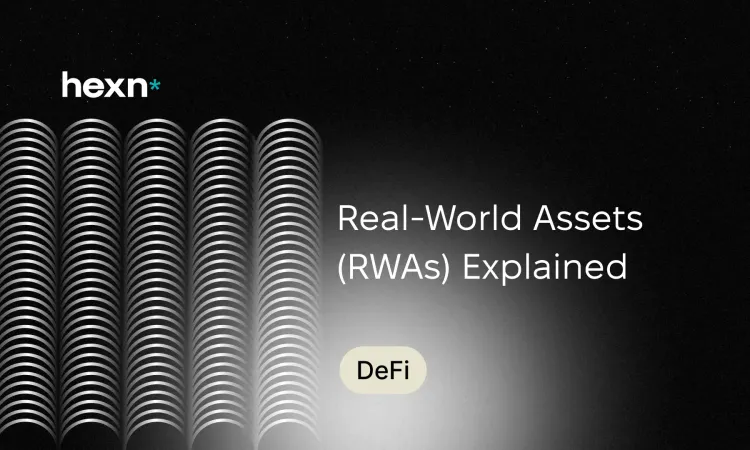Real-World Assets (RWAs) Explained
What Are Real-World Assets (RWAs)?
Real-world assets (RWAs) are physical or legally recognized items—like real estate, bonds, or carbon credits—that get represented as digital tokens on a blockchain. This tokenization links tangible value to on-chain instruments, creating new ways to trade, lend, and invest. For DeFi and fintech audiences, RWAs matter because they can bring real-world cash flows, diversification, and institutional capital into decentralized markets.
How RWA Tokenization Happens
Turning a physical asset into a trustworthy digital token is a multi-stage process. Each step reduces uncertainty and helps the token connect back to a real, enforceable asset.
Step 1 — Establishing Value and Ownership Off-Chain
Before anything goes on-chain, the asset must be verified in the real world. That means confirming its market value, inspecting its condition, and documenting clear legal ownership through deeds, invoices, or contracts. These off-chain checks form the legal backbone that supports any token linked to the asset.
Step 2 — Bridging the Asset to the Blockchain through Metadata
In the tokenization phase, descriptive information about the asset is embedded into the token as metadata. That metadata can include ownership details, valuation reports, and terms of transfer. When assets are regulated or could be treated as securities, issuers often apply compliance tools like KYC/KYB checks and use licensed issuance frameworks to align with local laws.
Step 3 — Bringing Tokens to Market and Matching Supply with Demand
Once tokens exist, DeFi protocols and marketplaces list, trade, or use them as collateral. These platforms help create liquidity by attracting buyers and sellers and can package RWAs into yield-bearing instruments. In practice, this step determines how useful the tokenized asset becomes in lending, borrowing, or yield generation.
Why RWAs are Drawing More Attention in DeFi
After volatile swings in crypto markets, many investors and protocols have started seeking assets with predictable income or cash flows. RWAs introduce elements of traditional finance that can make decentralized systems more resilient and attractive to long-term capital.
Some recent on-chain trends illustrate this shift: total on-chain RWA value (excluding stablecoins) increased by about $1.05 billion during 2023, with roughly $855.7 million—or 82%—coming from yield-bearing instruments such as treasuries, real estate, and private credit. Between January and September 2023, active on-chain private credit rose by $210.5 million while treasuries and related bonds expanded by $557 million. These figures show growing institutional and investor interest in tokenized real assets.
Who Issues RWAs?
RWA issuers are the entities that source physical assets, prepare the legal documentation, and mint the tokens. Their core responsibilities include acquiring or verifying the underlying asset, converting its rights or value into a digital form, and distributing tokens to investors or platforms that will use them.
Key Benefits of Bringing Real Assets On-Chain
- Improved liquidity: Tokenization can make traditionally illiquid assets, such as commercial property or private loans, easier to trade by subdividing ownership and enabling rapid transfers.
- Fractional ownership: Breaking an asset into smaller tokens lowers the entry barrier for investors and allows pooled ownership of high-value assets.
- Public verifiability: On-chain records provide transparent transaction history and provenance, making it simpler to audit ownership and transfers.
- Financial inclusion and product innovation: Tokenized RWAs can be integrated into DeFi products, opening new investment opportunities and creating more diversified yield options.
Practical Risks and Limitations
While promising, RWA tokenization also introduces challenges that projects and investors must manage carefully.
- Regulatory complexity: Different jurisdictions treat tokenized assets in varied ways. Compliance requirements can depend on the asset type, location, and whether tokens are considered securities.
- Security and custody: Maintaining a robust, legally enforceable link between the token and the underlying asset is essential to prevent fraud, disputes, or loss of value.
- Operational scalability: Platforms need strong infrastructure to handle high transaction volumes, ongoing asset reporting, and legal documentation at scale.
Final Thoughts on RWAs
RWAs have the potential to narrow the gap between traditional finance and decentralized systems by introducing tangible value and predictable cash flows to on-chain markets. They can expand access, add new yield sources, and attract institutional capital—but realizing that potential requires careful legal frameworks, strong asset custody, and resilient technical platforms. For investors and builders, RWAs represent an evolving field with real opportunities and clear responsibilities.
